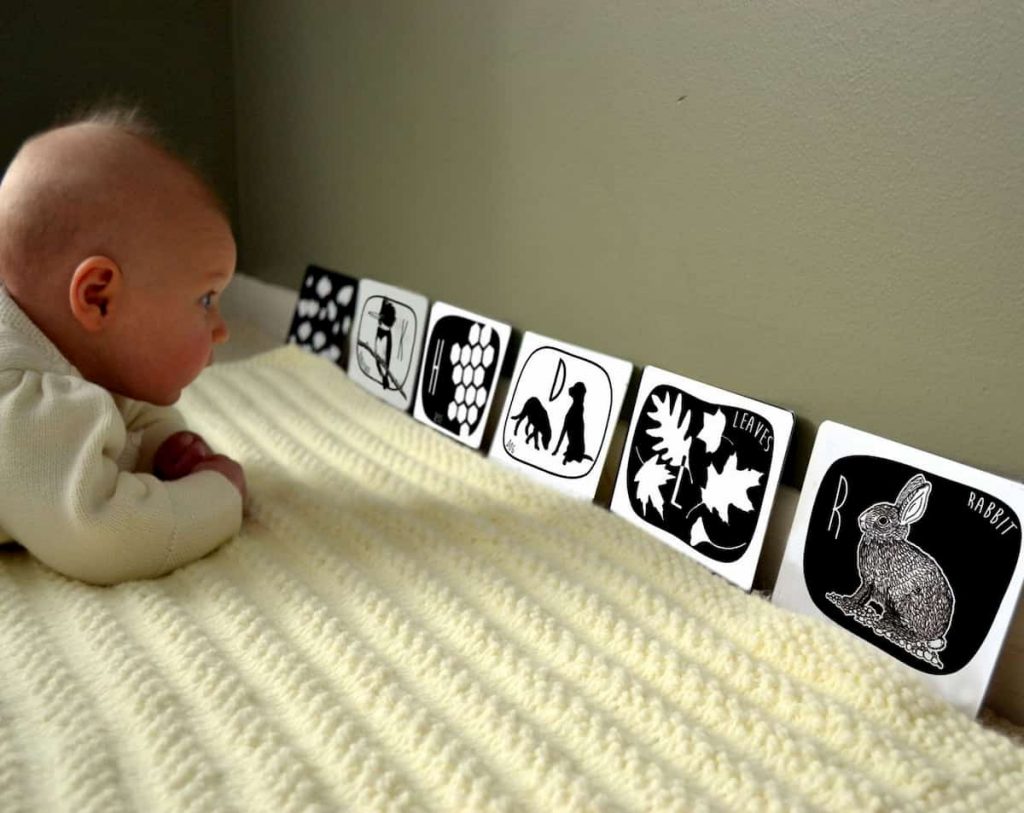When my first daughter was born, I was very actively interested in the Montessori technique. I learned about the low berth and other principles of creating a developmental environment for the baby, and I also learned about Montessori mobiles and black and white cards. Then I found a lot of contrasting pictures, printed them out and hung them like a garland near the place where my daughter spent time until she slept. Now many of my friends have newborn children and I remembered that it would be nice to make such material so that mothers could develop eyesight in tiny babies 🙂
Why black and white pictures?
Everything is simple. Surely you heard that newborns have poor vision. In the first days of life, the child’s eyes move randomly. After 20 days, the baby is a way to hold his eyes briefly on the subject. Gradually, the child’s gaze develops and he can see further and more clearly.
And newborns do not distinguish colors. Yes Yes! This is due to the fact that special cells (rods and cones) are located in the retina of the human eye. With the help of sticks, we see contrasting black and white images, and cones allow us to distinguish colors. So babies in the first month and a half of life have more rods, and cones develop a bit later.
To help the child learn to concentrate, you need to show him contrasting black and white pictures. The principle of introducing new images: from simple to complex. At first it can be the simplest lines, geometric shapes, then animal silhouettes and ornaments. From 2 months – bright color pictures, then more complex images.
I developed a set of pictures from simple to complex. The very first pictures are very simple, then there are silhouettes of animals of different detail. First choose those silhouettes that have a more understandable shape, and then enter more complex patterns. The most detailed in my selection are patterns. Use them closer to 3 months.
Download 62 black and white pictures for newborns
Changing pictures is not more than once a week.
How to use black and white cards?
- Hold the picture in your hands and just show the baby for a while, talk to him about something, let him hear your voice. The distance to the picture is not more than 30 cm.
- Attach the picture to the wall of the crib or somewhere in the field of vision of the baby at a distance of no more than 30 cm.
- Hang the card to the mobile so that the picture is horizontal.
- Place the picture in a frame and put it next to the place of feeding the baby. When he eats, he will be able to carefully consider the drawing.
I will be very glad if this material helps you enjoy the new things together in your newborn little man.


If someone has a limited amount of space in their home or shares a small nursery, do you have any advice for storing or rotating these cards so they do not clutter up the area but are still easily accessible for daily use?
It’s understandable to want to keep your space tidy while still supporting your baby’s visual development. You might try using a small basket or box to store the cards neatly in one spot, rotating just a few at a time for display. You could also use a folder or clear envelope to organize the cards by age or theme. Keep only the cards your baby is currently using within easy reach, and store the rest safely out of the way. Make sure the storage is out of your baby’s reach to avoid any choking hazards. This isn’t medical advice; if you’re concerned, check in with your pediatrician.
I often take my baby to stay with her grandparents, and they have a lot of colorful traditional decorations and cultural art around the house. Is it confusing for a newborn if there are both the black and white Montessori cards and these colorful items nearby, or should we adjust the environment when she visits?
It’s wonderful that you want to support your baby’s visual development while respecting your family’s cultural traditions. For newborns, high-contrast black and white images are easiest to see and help stimulate early vision. When visiting grandparents, you could place Montessori cards within your baby’s line of sight during quiet play or tummy time, while letting her enjoy the colorful decorations from a distance. No need to remove cultural items—just ensure your baby has the opportunity to focus on simple patterns for a few minutes at a time. Always supervise closely and keep small or delicate items out of reach. This isn’t medical advice; if you’re concerned, check in with your pediatrician.